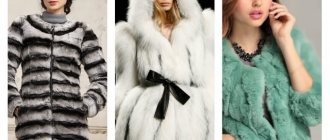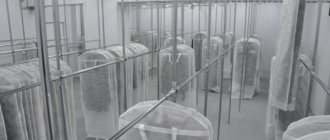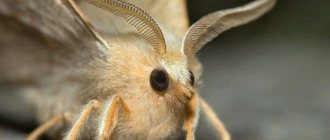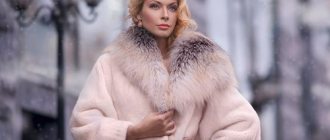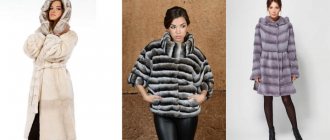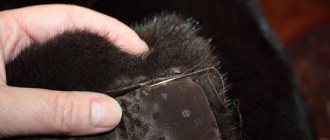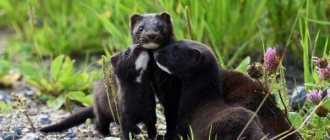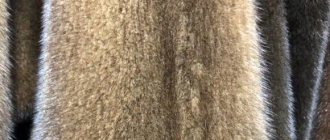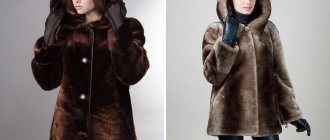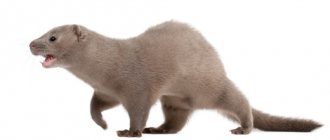How long will a fur coat last?
The answer to this question depends on what kind of fur it is made from. Thus, fur coats made from otter and river beaver fur are the most durable, they will last 20 seasons. Fur coats made from the popular mink are also durable - they will last about 10 seasons, from astrakhan fur, blue fox or marten - 7 seasons, and from nutria or fox fur - enough for 5 seasons. Squirrel fur coats will last 4 seasons, but rabbit and hare fur are the shortest and will last no more than two years.
AiF infographics
Features and Benefits
Due to difficulties in the production of natural fur products, counterfeits of mink, mouton or sable began to appear. Therefore, it should be taken into account that high-quality material is shiny, soft and easily deformed, returning to its original state. Such features of fur coats are difficult to fake.
Manufacturers consider the main advantages of fur products:
- Warmth in winter. Provides uniform insulation throughout the body.
- Individuality. There is practically no serial production, since identical skins do not exist in large quantities.
- Sufficient heat exchange. Natural fur allows warm air to pass through, but not cold air.
- Water repulsion. If the winter is wet, the best solution would be to purchase a beaver or yak. Such a fur coat will repel water particles without absorbing moisture.
- High strength. Many models serve for decades without losing their presentation.
- Social status. If you have a sable fur coat, a chinchilla model and other rare animals, you can show your financial level.
And thanks to the variety of styles, such outerwear will suit anyone, regardless of height, body type and age.
What determines the price of the product?
Firstly, the cost of a fur coat depends on the style and length. The quality of fur dressing is of great importance - a well-made fur product seems dense, “plump”. The fur coat is of good quality without any creases, the seams are neat. The price of a fur product also depends on the softness and shine of the pile.
In many products, small pieces of fur are “adjusted” using a special computer set. It is due to the use of such expensive technology that the cost of this fur coat is almost the same as a similar product made from solid plates. However, in terms of quality, durability and appearance, fur coats made from pieces selected by a computer program are inferior to a one-piece product.
Mink
The price of a mink coat largely depends on its color. The cheapest is walnut (light brown), then comes dark brown, then various red shades.
Even more expensive are black mink, beige, gray and blue, in the next price category are “tourmaline” (beige undercoat and long brown hair) and white fur.
The most expensive mink is called “black diamond” (black with a blue or purple tint). The warmest and most expensive fur coats are made from skins that have the top tags Platinum or SagaRoyal, NAFA or AmericanLegend. Such skins are distinguished by a thick down and a large amount of guard hair. Cheaper and less thick-haired skins are used to produce not so warm, but very light fur coats.
Choosing a quality fur coat based on fur type: main nuances
First, let's outline the general characteristics of real fur. Unlike a cheap fake, it is soft and manageable, does not stain your hands, does not crumble, does not have a specific smell and, of course, is pleasing to the eye.
Now let's talk about the nuances of choosing the right natural fur coat from different types of real fur:
- from mink
: the hair is soft, but tougher than that of a rabbit; shimmers and flows; elastic, obedient when stroking against the grain, the fibers are even in length and do not stick together. The price of mink skins depends on the color: walnut, dark brown, and red are less valued, while brown with a beige undercoat, white, and black with a purple tint are considered the most valuable;
Mink coat - from marten
: soft, lush, silky fur with long hairs of uniform density, without bald spots. The hand literally drowns in it. The color scheme is represented by rich shades of brown. The underfur is one tone darker than the overall color;
Marten fur coat - from river beaver
: heavy fluffy fur with thick undercoat; natural colors - from chestnut to dark brown; it differs from the cheaper nutria, which is often passed off as beaver fur, by a greater degree of fluffiness;
An example of a beaver fur coat - from mouton
: processed and dyed sheepskin has absolutely straight hairs, cut to 1.27 cm (shorter length is evidence of poor quality). The pile is smooth and soft like velvet. Has a natural shine;
Mouton fur coat - from astrakhan
: Very thick, shiny, tightly spaced hair with medium-length curls that form a clear pattern. The most common color is black, gray, golden, and white are less common;
Astrakhan fur coat - made of sable
: The hair of this image material has no equal in thickness, fluffiness and silkiness. The length of the hairs reaches 4 cm. The vertical spine completely covers the down. The color palette ranges from sandy to brown, sometimes with graying;
Sable fur coat - from rabbit
: the fur is short, thick and delicate, reminiscent of plush; all hairs are the same length; wide variety of colors: black with a blue tint, reddish-brown, silver, gray-white;
Rabbit fur coat - from fox
: the hair is long and thick, there are a great variety of colors: from the classic fiery red to white with a gray undercoat; the hair of a particularly valuable silver fox plays and shimmers in three tones: smoky gray (at the base), white (in the middle) and black (at the tip);
Coat of fox - from raccoon
: voluminous silky long-haired fur with a soft high awn and the same undercoat; typical colors: brown-beige, milky gray; The fewer yellow shades in the tone, the higher the value.
Raccoon fur coat
What to look for when purchasing?
When choosing a fur coat, you should be an extremely picky and attentive buyer. In particular, Rospotrebnadzor specialists recommend doing the following during the purchase:
Advice!
Having chosen a silver fox fur coat, take a closer look at the fur - it should be three shades (gray, white, black). If the fur has only two shades, then you have a fur coat made of fox dog (a hybrid of fox and arctic fox).
- Examine the fur and evaluate its thickness. If the fur seems not thick enough, check with the seller exactly when the animals were slaughtered, from whose skins the fur coats were made. The fact is that animals have the thickest and fluffiest fur in winter; they shed in summer. In addition, such an effect can be generated by poor-quality dressing of the skins, or more precisely, by their excessive stretching.
- Run your hand against the fur - the down should be thick enough, and long hairs should not break. In addition, the fur should quickly fall into place, the skin should be soft to the touch. Feel free to squeeze, crumple, pull the pile - a good product will survive these manipulations.
- Tug the fur . If you have hairs in your hand that have separated from the skin of your fur coat, it will shed constantly.
- Shake your fur coat . If the villi do not fall off too intensely (any new fur coat will shed moderate hairs after the drying procedure), everything is fine, but if the fur coat “rattles” like oilcloth, the fur is overdried, such a product is unlikely to be worn for a long time and will quickly lose its shape.
- Check whether you are really dealing with natural fur and not dyed - spread the undercoat with your fingers and check the color of the skin. The skin of a skin that has not been dyed remains white. If you want to buy a dyed fur coat, rub the fur with a handkerchief - high-quality dyes should not leave marks.
- Pay attention to the seams - they should be stitched thinly, neatly and almost not palpable. There are glued fur coats on the market; glue is used instead of seams; such a fur coat is not worth our attention; if you find a glued fur coat, do not buy it under any circumstances.
- Ask the seller to tear off the lining of the product and show you the inside of the product. If the pieces are approximately 15x15, the product is of high quality. If they are much smaller, the seams are made sloppily - you are looking at a thing that in 2-3 years will no longer be a source of pride for you.
- Study tags and manufacturer's information . When purchasing, it is better to give preference to a product that has tags with the name and address of the manufacturer, as well as a product that has a warranty.
- Try on different styles of fur coats until you find the one that suits you best.
Size
One of the important guidelines in the process of choosing a fur coat is compliance with the parameters. The item should not be tight. Classic models have a loose fit. If you buy a thing that is voluminous in shape, you can lose the main highlight and feature.
Long
Petite women are drowning in long flared fur coats. And to correct a round silhouette that does not have a waist, a peplum along the hem or a large collar will help.
Short
Those with a large bust and hips prefer shortened trapezoidal upper clothing. Tall and thin ladies choose sable or arctic fox fur or mink cross-section - a fur coat sewn from skins crosswise.
Average
Outerwear with a size up to mid-thigh, extensions towards the bottom and an emphasis on the waist emphasizes slimness.
Fur options table:
| Fur | Wearing time (seasons) | Sustainability | Heat | Product weight |
| Otter | 15-18 | 98% | hot | big |
| Wolverine | 18 | 99% | hot | average |
| Brown and black bear | 18 | 94% | hot | big |
| River beaver | 16 | 90% | hot | big |
| Sable | 15 | 85% | hot | big |
| Raccoon | 8 | 80% | warm | big |
| Mink | 11 | 75% | warm | average |
| Soft marten | 6-8 | 67% | warm | average |
| Sheepskin (mouton) | 6-8 | 65% | hot | average |
| Astrakhan | 5 | 55% | warm | average |
| Arctic fox | 6-8 | 60% | hot | average |
| Wolf | 8 | 60% | hot | big |
| Mountain marten | 4-5 | 60% | warm | average |
| Muskrat | 4-5 | 50% | warm | big |
| Nutria | 4-5 | 50% | warm | big |
| Lynx | 4-5 | 45% | hot | average |
| Fox | 3-4 | 40% | hot | big |
| Squirrel | 3-4 | 30% | warm | easy |
| Silver fox | 3-4 | 27% | hot | average |
| Ermine | 3-4 | 25% | warm | average |
| Chinchilla | 3 | 17% | warm | easy |
| Rabbit | 3 | 12% | chilly | easy |
| Brown hare | 2 | 6% | warm | average |
See also
Beautiful models of fluffy dresses, what to wear them with and how to choose the length
Life time
Any fur product has a wear period. In the table, this is “Wearing time”, determined by seasons. Typically, a properly cared for fur coat will last at least 10 years.
The time frame is significantly shortened if the product, which is not intended for moisture, is constantly worn in both snow and rain. And also the durability will be reduced by at least a quarter if the storage conditions are violated.
Storage rules
A fur coat is a practical item that will last an order of magnitude longer if you take care of it properly, since the item is natural. Outerwear must be hung on hangers with wider brims than the shoulders of the owner of the item. An ideal option if the fur coat is hanging in a case in the closet. It is not recommended to store a dyed product with light colored ones, as staining may occur.
Cleaning your home yourself is not recommended, since it is better to trust fur items to dry cleaning. A slightly wet fur coat is easier to dry. To do this, the item is shaken and then laid out on the floor or other surface. Leave to dry at room temperature. It is unacceptable to place the product close to a radiator or other heating devices. After final drying, the fur is cleaned with a brush along the pile.
Description
What animal is the mouton fur coat made from? Mouton fur is obtained after shearing sheep of a certain breed. They are bred in Austria, Argentina and New Zealand. Russian Mouton is obtained from the Merino sheep breed, which is bred in the Caucasus. During processing, fur is obtained that can replace expensive furs - sable or mink.
The cut mouton has a uniform, elastic and shiny pile. If you press it, the pile will not be deformed and will quickly return to its original state. There is a wide variety of mouton fur in color, weight and cutting method. And they are all heavy.
The main features of the mouton include:
- Thick and dense pile.
- Shape stability.
- Beautiful natural shine.
- Heavy weight.
- On the reverse side there is leather.
- Strong connection of fibers.
Heat preservation
Bear and reindeer are considered the warmest, but such products are not common in domestic countries. Animals such as sable or arctic fox are quite warm. These animals have a large amount of guard hair and thick undercoat. But such products are large in weight.
Astrakhan fur, mink, ermine and chinchilla have lower heat resistance. It is almost impossible to freeze in winter with a goat, rabbit and marmot.
And the gopher, rabbit and hamster will keep you warm only in the fall.
The game is worth the candle!
If you compare all the advantages of a mouton with such popular furs as mink, arctic fox and otter, it becomes obvious that clothes made from a mouton are not an alternative to expensive furs. This is a full-fledged representative of the most popular part of the fur industry. Mouton is becoming more and more popular from season to season. Products made from it are suitable for both men and women. Clothes made from mouton are worn by children, teenagers, respectable women and men. Mouton became an ageless fur. Its durability to wear, ease of care and variety of colors and patterns make this fur truly valuable.
